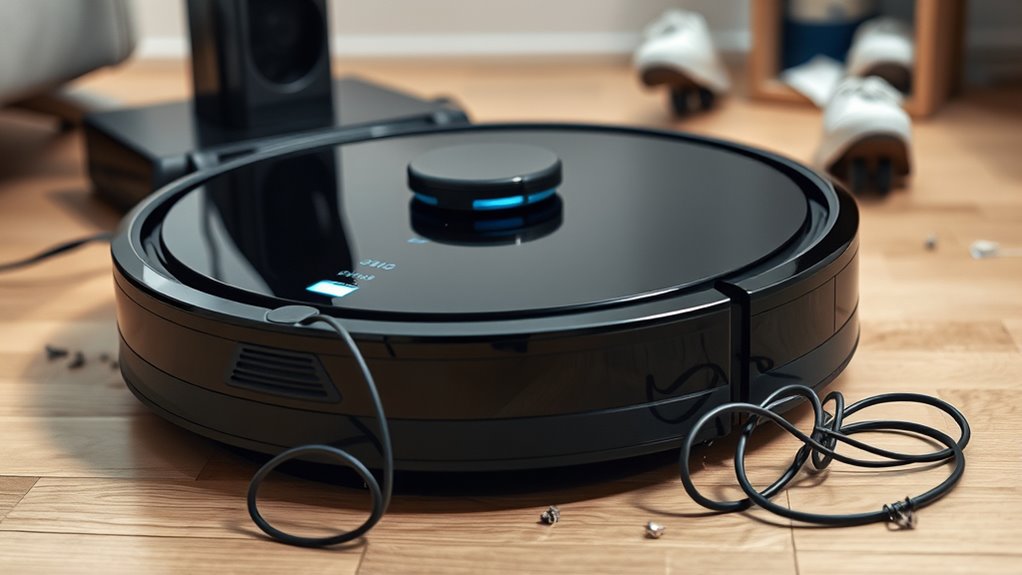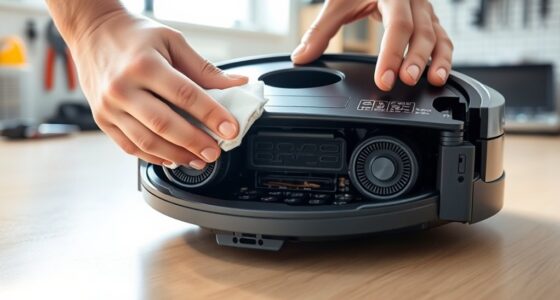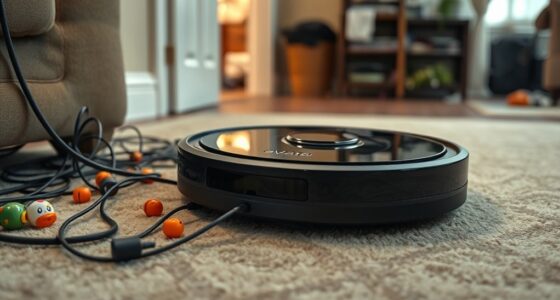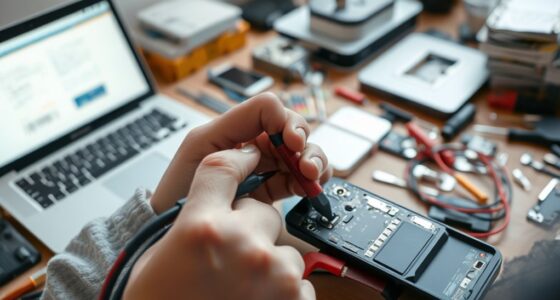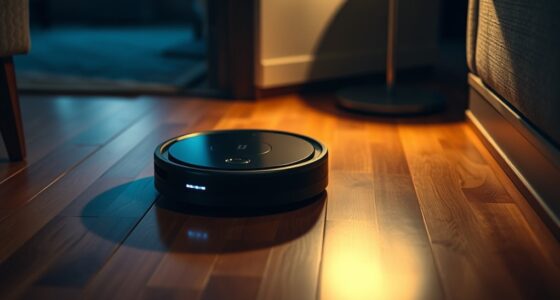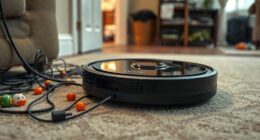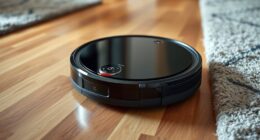If your robot vacuum won’t dock, start by checking the placement of the charging station—ensure it’s on a level, open surface away from obstacles and clutter. Next, examine the battery health; old or damaged batteries can prevent proper docking. Keep firmware and sensors clean, as dirt or outdated software can interfere with navigation or charging signals. If problems persist, addressing these areas can often restore successful docking, and there’s more to explore if you want to fix it fully.
Key Takeaways
- Ensure the charging station is on a level, open surface away from obstacles and clutter.
- Check and replace the robot’s battery if it drains quickly or docking takes too long.
- Clean charging contacts and sensors regularly to prevent dirt or corrosion interference.
- Update the robot’s firmware through the app for optimal navigation and docking performance.
- Verify the charging station placement is accessible, unobstructed, and properly aligned for the robot to dock easily.
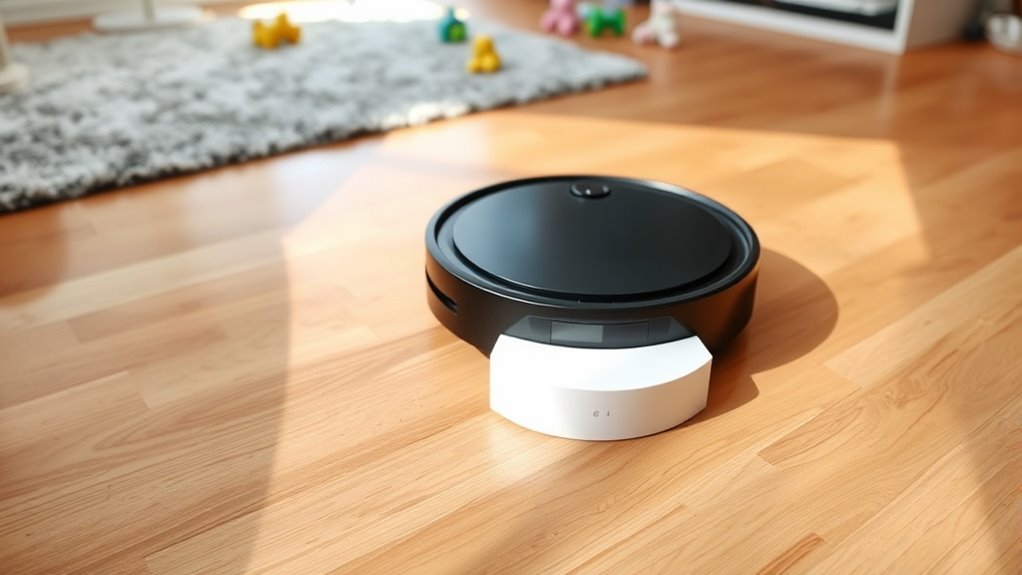
If your robot vacuum is having trouble docking correctly, it can be frustrating and disrupt your cleaning routine. One of the most common reasons for docking issues is improper charging station placement. You want to ensure your charging station is positioned in an open, flat area that’s easily accessible by your vacuum. Avoid placing it near obstacles, low furniture, or in tight corners where the robot might struggle to find its way back. The station should be on a level surface, away from clutter and away from areas with high foot traffic, which could cause the robot to get distracted or knocked off course. Additionally, keep the station power cord tidy and free of tangles to prevent the robot from bumping into or disconnecting it during docking.
Place your charging station on a level, open surface away from obstacles and high traffic areas for proper docking.
Another factor that can cause docking problems is battery health issues. Over time, batteries lose their capacity to hold a charge, which can hinder the robot’s ability to return and dock properly. If your vacuum is frequently running out of power quickly or takes longer than usual to dock, it might be time to check the battery. Some models allow you to replace the battery, so consult your user manual for guidance. If the battery is old or damaged, replacing it can restore proper docking function and overall performance. Remember, a healthy battery is essential for accurate navigation and successful docking; otherwise, the robot may struggle to reach its charging station or may shut down prematurely before docking.
You should also verify that your robot’s software is up to date. Sometimes, docking issues stem from outdated firmware that affects navigation algorithms. Most brands offer an app that automatically updates the firmware, so make sure you’re running the latest version. Clear any debris or dust around the charging contacts on both the robot and the station, as dirt or corrosion can interfere with the charging process and cause docking failures. Clean contacts gently with a soft cloth or a brush to ensure proper connection.
Furthermore, paying attention to the suction power and sensor performance can help improve navigation and docking success. If your robot’s sensors are obstructed or malfunctioning, it may have difficulty locating the charging station accurately. Resetting the robot or recalibrating its sensors can sometimes resolve these issues. To conclude, proper placement of the charging station, maintaining battery health, keeping contacts clean, updating firmware, and ensuring optimal sensor performance are essential steps to troubleshoot docking problems effectively. Addressing these areas can help restore smooth, reliable docking and keep your robot vacuum running efficiently.
Frequently Asked Questions
How Often Should I Clean the Charging Contacts?
You should clean the charging contacts regularly to keep your robot vacuum working smoothly. The cleaning frequency depends on how often you use your vacuum and the environment, but generally, once a month is enough. Dirty charging contacts can prevent proper docking. Use a soft cloth or a cotton swab with a bit of rubbing alcohol to gently clean the charging contacts, ensuring a good connection each time you charge your robot.
Can Wi-Fi Interference Affect Docking Functionality?
Wi-Fi interference can definitely affect your robot vacuum’s docking ability. Wireless signals and signal interference from other devices may disrupt the vacuum’s communication with its dock, causing it to miss or ignore the charging station. To prevent this, make sure your Wi-Fi router isn’t too close to the dock or vacuum. Reducing wireless interference helps maintain a strong connection, ensuring your robot can dock and charge properly without issues.
Is It Normal for the Robot to Beep When Docking?
When your robot vacuum beeps during docking, it’s not necessarily cause for concern; it’s just its way of communicating. Beeping patterns often serve as docking cues, indicating it’s aligning or encountering an issue. If the beeping is consistent and matches the docking process, it’s normal. However, irregular patterns might signal a problem, like misalignment or obstacles. Keep an eye on the beeping to understand your robot’s signals better.
What Should I Do if the Dock’S Indicator Lights Are Blinking?
If the dock’s indicator lights are blinking, it usually signals a problem. First, check your robot’s battery maintenance; a low or faulty battery can cause docking issues. Then, verify the sensors are calibrated properly, as dirty or misaligned sensors might prevent docking. Reset the robot and clean the sensors gently. If the problem persists, replace the battery or recalibrate the sensors to restore proper docking function.
How Does the Robot Recognize Its Docking Station?
Your robot recognizes its docking station through navigation sensors that detect signals and visual cues. To guarantee proper recognition, you should place the docking station in an open, unobstructed area, avoiding thick carpets or clutter that can block sensors. Proper placement helps the robot’s sensors easily locate the station, allowing it to dock efficiently. Keep the station’s signals clear and consistent for seamless navigation and docking every time.
Conclusion
If your robot vacuum still won’t dock, don’t give up. For example, Sarah’s vacuum kept missing the charging station until she cleaned the sensors and adjusted the docking area. By ensuring sensors are clear and the dock is accessible, you can fix most issues. Remember, regular maintenance makes a big difference. With a little troubleshooting, your robot can return to its charging station seamlessly, keeping your floors spotless and your device ready to go.
